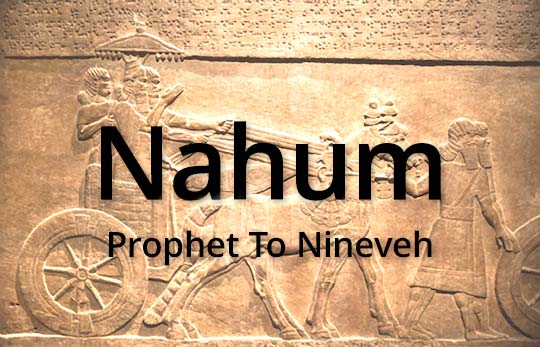Bible Question:
Who was the prophet Nahum?
Bible Answer:
The prophet Nahum (“full of comfort”) wrote the book of Nahum as stated in Nahum 1:1.
An oracle concerning Nineveh. The book of the vision of Nahum of Elkosh. Nahum 1:1 (NASB)
What is a prophet? He is one who speaks a message from God to someone else. That is exactly what Nahum did. The prophet spoke a message of coming judgment against the Assyrian capital of Nineveh (Nahum 1:1; 2:8; 3:7). But the question we are concerned with is who was Nahum? Therefore, we will examine the date of Nahum’s ministry, the city of his birth, and the region of his ministry.

Date of Nahum
Several clues are given in the book of Nineveh that helps us estimate the time that Nahum communicated God’s oracle against Nineveh. The first clue as to the date of the prophecy of Nahum is given in Nahum 3:8-10 when the prophet refers to the defeat of No-Amon or Thebes. This event occurred in 661 B.C. The second clue as to the writing of the book of Nahum is that the prophecy is about the coming destruction of Nineveh (Nahum 1:1; 2:8; 3:7). Historical records reveal that Nineveh was destroyed in 612 B.C. This means that the prophecy was given sometime between 661-612 B.C. When did the author write the prophecy? Gleason Archer states that Walter Maier strongly supports a date of 654 B.C. as the best date for when the prophecy was given and written.[1] This means that Nahum was a prophet before 654 B.C. and for years afterward.
Birthplace and Ministry of Nahum
Now that we know the approximate time of Nahum’s ministry, we want to know where he was born. The only information we have about the personal life of the prophet is given in Nahum 1:1. There we are told that Nahum was of Elkosh. He was an Elkoshite. We assume that this was his birthplace. There is much debate as to the location of this city. Most authors who attempt to determine the location of this ancient city have proposed one of four locations in Assyria, Galilee, and Judea.
North of Nineveh – The first option for the location of Elkosh is that the modern-day city of Al-Qush. The ancient site was located twenty-five miles north of ancient Nineveh. The tomb of Nahum was located in Al-Qush during the sixteenth century.
Hilkesei in Galilee – The early church father Jerome (A.D. 347-420) stated that the city of Elkosh was located in Galilee. This city is called Elkesi, Hilkesei or El Krause. Yoshitaka Kobayashi states,
According to the prologue of Jerome’s commentary on Nahum, “Elkosh was situated in Galilee, since there is to the present day a village in Galilee called Elkesi (or Hilkesei), a very small one indeed, and containing in its ruins hardly any traces of ancient buildings, but one which is well known to the Jews, and was also pointed out to me by my guide.” Modern el-Kauzeh might be the site to which Jerome referred.[2]
Capernaum in Galilee – A third proposal for the location of Elkosh has been the city of Capernaum which is located along the western seashore of the Sea of Galilee. The reason some believe that this city is Elkosh is that Capernaum is K’par Nahum which means “village of Nahum.” Those who believe that Capernaum was the prophet’s home city suggest that Elkosh was later renamed as Capernaum.
Elcesei In Judah – The fourth view was proposed by early church fathers such as Pseudo-Epiphanius that Elkosh is the city of Elcesei in southern Judah between Jerusalem and Gaza. Since Nahum 1:15; 2:2 refers to Judah this proposal has credibility.
Which view is correct? The most likely option appears to be the fourth view. However, we cannot be certain.
Message of Nahum
God gave Nahum a strong message to the ancient city of Nineveh, the capital of Assyria. Because the Assyrian empire had defeated the northern kingdom called Israel (Nahum 1:2, 11) and its excessive evil (Nahum 1:8, 14; 3:5-7), God communicated that the empire would be destroyed (Nahum 1:12-14). Even though God had used the Assyrian empire to punish the northern king of Israel for its sin of apostasy, the empire was excessively evil (Zechariah 1:13-15), therefore, God would destroy the empire. That was the message of the prophet of Nahum.
Conclusion:
Scripture reveals very little about the prophet Nahum. Nevertheless, we know when he received the oracle from God and where he may have lived. But we do not know anything about his parents and life. Yet, we know that he was a righteous and godly man since he was a prophet. Scripture declares that the ancient prophets were “holy prophets” (Luke 1:70; Acts 3:21; 2 Peter 3:2). In 1 Peter 1:15-16 God urges all believers to be holy. May we be holy as He is holy.
. . . but as he who called you is holy, you also be holy in all your conduct, since it is written, “You shall be holy, for I am holy.”
References:
1. Gleason Archer. A Survey of the Old Testament Introduction. Moody Bible Institute. 2007. pp. 332-333.
2. Yoshitaka Kobayashi, “Elkosh (Place),” ed. David Noel Freedman, The Anchor Yale Bible Dictionary (New York: Doubleday, 1992), 476.